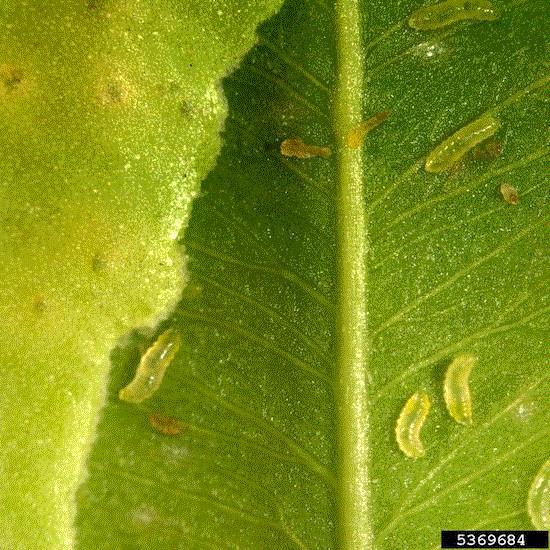More tips on boxwood blight management
Happy New Year!
All is quiet on the pest management front. That’s what a holiday is all about, right? Rest, reflect, and regroup. I also want to follow up on a couple of leads that emerged after the last newsletter.
Gail Ruhl of Purdue University introduced me to the website of Virginia Tech’s Boxwood Blight Task Force. The website archives several webinars on boxwood blight, posts best management practices for nurseries, landscape professionals, homeowners and others, provides recommendations on surface sanitizers and fungicides, and contains numerous images to help tentatively diagnose boxwood blight. The fungicides are grouped by homeowner and professional use, and listed with their modes of action and efficacies.
One of the largest boxwood growers is Saunders Brothers in Piney River, Virginia. The nursery will preview its newest selection of boxwoods—NewGen Boxwood—at MANTS 2019. Saunders Brothers advertises that the NewGen boxwood selections are more tolerant of boxwood blight and more resistant to boxwood leafminer. The new boxwood selections will become available in late 2019 and early 2020.

I’m curious about this NewGen selection, particularly its purported tolerance/resistance against boxwood blight and leafminer. If the tolerance or resistance holds up under rigorous testing, the new selections will represent welcome additions to our pest management arsenal. Can’t help my critical self though; I have to see the results for myself. You can check it out at MANTS, January 9-11, in Baltimore, Maryland.

Tips on boxwood leafminer management
While we are on the subject of boxwood, I want to talk about the other major pest of boxwoods—the boxwood leafminer—even though it’s a bit too early in the season to talk about its management.
I've run across a few incidences of this little leaf-mining gnat, but most of the “victims” were from Upstate South Carolina or further up north. Although the boxwood leafminer can be found anywhere boxwood is grown, its pest status is much less severe on the coastal plains. And, infestation is much more common in landscapes where boxwoods typically do not receive as much pest management attention as they do in nurseries. No boxwood species or cultivars are completely immune to the boxwood leafminer. American boxwood seems most susceptible, but susceptibility also varies among English and Japanese boxwood cultivars.
Infestation by the boxwood leafminer is not difficult to identify. The most telltale symptom is the yellow or brown blisters on the leaves. Severe infestation can cause the entire boxwood bush to look yellowish. Or, very few leaves may remain because of severe leaf drop. You can find several juicy yellow maggots in a blister if you open it in late summer and fall. Joe Boggs of The Ohio State University has posted some great pictures on his BYGL blog.

Boxwood leafminer larvae inside a blister. (Photo credit: Nancy Gregory, University of Delaware, bugwood.org)
Gabriel d’Eustachio and Mike Raupp of University of Maryland demonstrated in a 2001 Journal of Arboriculture paper that the efficacy of insecticide treatment is closely tied to the life cycle of the leafminer. The boxwood leafminer has only one generation per year, with the adults becoming active in late April (or 352 growing degree-days) in Maryland and at peak activity in early May (around 440 growing degree-days). Adult emergence correlates closely with the spring flush of boxwood leaves and flowering of weigela. Adults are small gnats, somewhat pinkish or orange in color. The leafminer overwinters as third-instar larvae in the blisters.
Boxwood leafminer populations can be effectively reduced with foliar sprays of insecticides, such as spinosad (Conserve), abamectin (Avid), organophosphates, pyrethroids and neonicotinoids. Gabriel and Mike demonstrated that sprays of abamectin (Avid) and imidacloprid (Merit) at the time of adult activity reduced the leafminer population by 85%. If you wait until July to make the application, only the imidacloprid treatment results in population reduction.
In my experience, systemic insecticides represent the most effective options for boxwood leafminer management. Neonicotinoids, such as imidacloprid, clothianidin, dinotefuran and thiamethoxam, are effective when applied as soil drench or foliar spray. Another neonicotinoid, acetamiprid (TriStar), is registered for foliar spray and basal bark treatment. Their efficacy allows for greater flexibility in application timing. I often recommend soil application just after the end of adult activity or in the fall. A study by Carl Redmond and Dan Potter in Kentucky (published in Arboriculture and Urban Forestry in 2017) showed that a soil drench treatment with imidacloprid in October and April achieved 90% and 99% control, respectively, of boxwood leafminer. Soil drench of dinotefuran and thiamethoxam in the spring were also effective. I find that one application can often solve the infestation problem for multiple years before another application is needed to reduce the increasing infestation.
Other systemic insecticides, such as chlorantraniliprole (Acelepryn), cyantraniliprole (Mainspring) and flupyradifurone (Altus), are registered for various leafminer species, but not boxwood leafminer specifically. The efficacy of these insecticides against boxwood leafminer is unknown. The study by Carl and Dan showed that soil drench treatment of chlorantraniliprole in April or October didn’t achieve significant reduction in leafminer population.

Cannabis as conundrum
That’s the title of a recently published opinion paper (in the journal Crop Protection) by Leah Sandler, Janna Beckerman, Fred Whitford and Kevin Gibson of Purdue University. That’s a very apt description of the situation facing growers of industrial hemp and marijuana.
The paper was prepared before the 2018 Farm Bill legalized industrial hemp, but it’s still a very enlightening read for anyone who is interested in pest management for cannabis. The issues outlined in the paper will remain for many years to come until the federal and state governments can emerge from the “convoluted, confusing, and impractical” regulatory and legal framework governing the production and use of cannabis. I was heartened by what I read, not only because “Smart Girl” Janna introduced me to the paper, but also because the paper laid out my long-held concerns with pest management on cannabis more lucidly than I can ever dream of doing.
The paper reviews the common pests and diseases, and provides some jaw-dropping facts about pesticide residues on marijuana. I’m not going to spill the beans here; the shock effect is better if you read it first-hand.
Leah and her colleagues outlined six conundrums in this paper:
-
Conundrum # 1, which is perhaps the seed of all conundrums, is the fact that the Controlled Substance Act declares all cannabis varieties, including industrial hemp, as a Schedule I controlled substance.
-
As long as cannabis remains a Schedule I drug, EPA will not approve registration of pesticides for use on cannabis regardless of the legalization of use and production at the state level. Pesticide manufacturers will not invest in research to support registration.
-
A tolerance (i.e. the maximum amount of pesticide residue allowed to remain in or on a crop) for each crop must be established before EPA can make a registration decision. Superseded by federal drug enforcement laws, EPA does not allow for the establishment of tolerance for cannabis as long as it remains a Schedule I drug.
-
States have tried to circumvent EPA registration through alternative EPA policies and programs, such as Special Local Needs (Section 24C), Emergency Exemption (Section 18), Reduced Risks (Section 25B) and USDA Minor Use Program (particularly through IR-4). These efforts have met with varying levels of resistance from EPA and manufacturers, poor efficacy and other issues.
-
In the face of not having legal use of pesticides, some cannabis growers opt for going “off” the label and use pesticides illegally.
-
The impacts of illegal pesticide use on the health of cannabis users cannot be assessed because EPA has failed to conduct comprehensive risk assessments, and there has been no systematic monitoring to identify risks. Risks to users will likely differ depending on the use patterns; thus, each use pattern will have to be regulated separately to ensure consumer safety.
I don't have a magic 8-ball. Even if I did, it would probably tell me to “ask again later” on the question of how the hemp industry will change after the 2018 Farm Bill. But it’s clear that regulators at the federal and state levels will need to get their acts together, and the hemp industry will also need to self-regulate and develop policies that safeguard product quality and consumer, worker and environmental safety. There is still a lot of work to do, but it has to start now.






See y'all next time!

JC Chong
Associate Professor of Entomology at Clemson University
This e-mail received by 24,823 subscribers like you!
If you're interested in advertising on PestTalks contact Kim Brown ASAP!